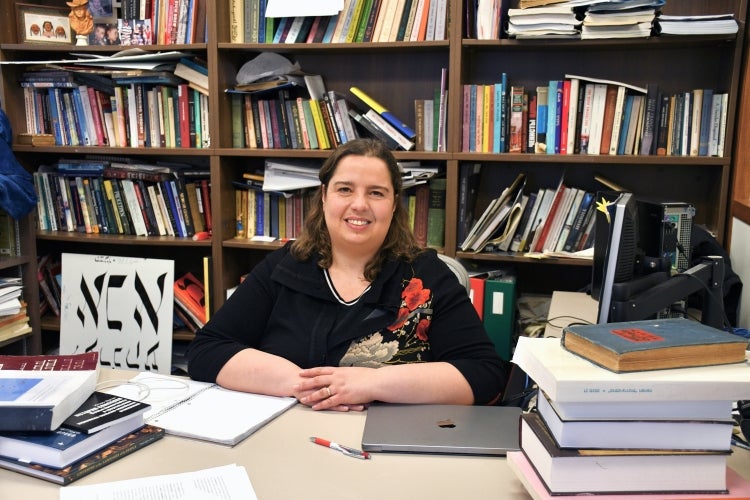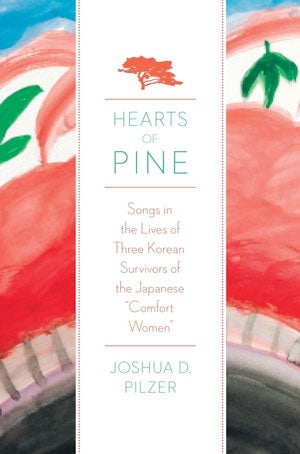Wars, Diaspora & Music: U of T courses explores the role of music during times of war

Simon Bikindi, right, a Rwandan singer-songwriter, is pictured with his lawyers and a United Nations guard at the International Criminal Tribunal for Rwanda in 2008 (photo by STR/AFP via Getty Images)
Published: December 7, 2023
In the 1990s, Simon Bikindi was Rwanda’s most popular musician – a United Nations official even dubbed him the “Rwandan Michael Jackson.” A sometime wedding singer, Bikindi’s lyrics often told of love stories and his country’s beautiful landscape.
But Bikindi’s music could also be dangerous. Over the three months in which almost a million Tutsis were massacred during the Rwandan Civil War, the country’s Radio Télévision Libre des Milles Collines repeatedly broadcast the singer’s violent, inflammatory songs. In 2008, Bikindi, an ethnic Hutu, was convicted for his role in inciting war crimes.
The Bikindi story is but one of the case studies covered in “Wars, Diaspora and Music” – a University of Toronto course in the Faculty of Arts & Science that explores the important role that music often plays in ethnic conflicts, wars, exile and displacement.
“We look at how music can be a weapon – as military music and propaganda,” says course creator Anna Shternshis, the Al and Malka Green Professor of Yiddish Studies and director of the Anne Tanenbaum Centre for Jewish Studies.
“But we also look at songs created by people under duress – songs about love and the reclamation of humanity, when everything has been destroyed.”
Shternshis says she conceived of “Wars, Diaspora & Music” while working on Yiddish Glory, the Grammy-nominated album of Holocaust-era Yiddish songs she assembled with Russian performer Psoy Korolenko.

Yiddish Glory is part of the course’s syllabus, along with music from many other conflicts of the 20th and 21st centuries. That includes music from Rwanda, Korea, Bosnia, Afghanistan, Ukraine and Palestine.
“I decided to take this course as I had never heard of anything like it,” says Anjali Joshi-Dave, who is in her third year as a member of Trinity College. “Although I do not play any musical instruments, I adore music and was interested to see its connection to violence and diasporas from an academic perspective.”
Gabriella Batikian is a fourth-year member of Victoria College. A member of the Armenian diaspora, she grew up listening to a wealth of music from her heritage – much of which was produced around the time of the 1915 Armenian genocide.
She says the course helped her contextualize such music, as well as that from other countries.
“We do a deep analysis of the lyrics that we’re studying,” Batikian says. “And it’s really interesting to learn how music can be used for good and for bad. We’ve learned how it can be used as a propaganda tool and to incite violence. But at the same time, music is also used to comfort survivors of war. That’s the main thing – discovering the power that music truly holds.”
War invariably involves displacement – hence its connection to diasporic communities longing for home. To this end, students learn about initiatives such as the U.S.-based Refugee Orchestra Project.
Shternshis is a scholar of refugee experience and a supporter of refugees in Toronto.
“In class, we’ve discussed what kind of music is created in refugee camps,” she says. “Listening to music like this becomes a way of learning what people really care about. And I think that when students examine events in future, they will count music among the sources they use to try and make sense of them.”
By studying music produced within different conflict environments, Shternshis has drawn several unique insights. She notes, for example, that the closer a musician is to conflict, the less “martial” the music becomes. That includes war songs in which soldiers sing about their loved ones back home, or joke about inferior army food.
“A lot of soldiers also learn to play a musical instrument, because they desperately need the emotional break,” she says.

The course also features a unit on Hearts of Pine, a book by Joshua Pilzer, an associate professor in the Faculty of Music. The book explores how Korean women used song as a means of coping with trauma while forced into sexual enslavement during the Second World War.
“When people live through sexual violence in war, very few songs describe the violence itself,” says Shternshis, noting it was a phenomenon she noticed when interviewing Holocaust survivors who were also musicians. “They sing about everything else but that.”
Shternshis has been teaching “Wars, Diaspora & Music” since 2018 and changes the syllabus every year to incorporate music from the world’s current wars. “I keep hoping that this will become a historical course,” she says ruefully. “But it is always contemporary.”
Last year, for example, she monitored music – emerging in real time on social media – created during the Russian invasion of Ukraine. This year, she and her students are keeping watch on music from the Israel–Hamas war with the help of a student translator.
While it is painful to engage with contemporaneous pain, Shternshis says it’s a valuable way of recording experiences and emotions that are easily forgotten with the passage of time.
What unites the music studied in the course is its enormous power – both to incite killing, as in the case of Rwanda’s Bikindi, but also to provide healing.
Shternshis says the latter may ultimately be stronger than the former.
“If a person who lives under extreme duress is able to enjoy music, that often gives them incredible strength to move on,” Shternshis says, adding that her course offers a glimpse of the human spirit at its most threatened – and most triumphant.
“We are asking: What are the things that people are saying, or singing, or even laughing about in conditions that are not designed for life at all?”



